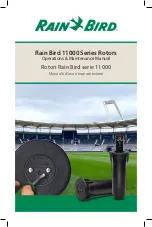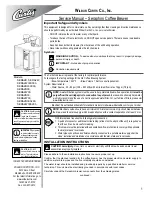
CHAPTER 6
MAINTENANCE
6.1
THE FIRST FEW WEEKS
Once your
HURRICANE
heater has been installed to approved standards and workmanship, and you
have test operated it a few times, your HURRICANE heater requires little maintenance.
About two weeks after your HURRICANE heater has been running, you should conduct
a general inspection of the entire system.
•
Check for any leaks in the exhaust, fuel, or water systems. Tighten all clamps.
6.2 ADDING
ANTIFREEZE
Once the system has been filled with water and purged of all air during the installation procedure, you
need to operate the heater at normal temperatures and then check for water leaks. If you do not find
any, add antifreeze to lubricate the pump and prevent the water system from corroding or freezing in
cold weather. See Chapter 3, “Water filling procedures”, page 3-11.
PRECAUTION: Where there is a chance of contamination of your domestic water when using a
heating system, use antifreeze specifically intended for hydronic heating systems. Inhibited
propylene glycol is recommended. Do not use automotive, ethylene glycol, or any undiluted or
petroleum based antifreeze as they can cause severe personal injury.
IT IS VERY IMPORTANT THAT YOU NEVER USE WATER ONLY AS A COOLANT.
We recommend that you add a mixture of 50% water and 50% antifreeze. NEVER use
more than a 50/50 mixture, since the added viscosity of the antifreeze solution will
cause circulation problems. Your antifreeze/water mixture should be changed every
three years. Antifreeze does wear out and can become very acidic.
A coolant conditioner should can be added to the water system, to keep the coolant alkaline and not
acidic, see page 3-14. These inhibitors also prevent the coolant from forming calcium scales.
Conditioners are available from diesel engine manufacturers to maintain water stability and prolong
heater life. If a conditioner is not installed in your system, check the pH level yearly. The components
inside the heater should not normally require maintenance, except for periodic checks for obvious
problems, such as leaks or overheating.
6.3
MARINE EXHAUST SYSTEM
Always be careful that nothing combustible is placed adjacent to the exhaust pipes.
While the exhaust system is made of a high quality stainless steel material, it is still affected by the
marine environment. Check the general condition of the pipes every so often for possible leaks and
corrosion. Service as required and replace corroded pipes immediately. On rough seas,
there is a danger of water entering the exhaust outlet. Ask your dealer about a thru-hull
plug that can be inserted into the exhaust outlet when the boat is moving through rough
water. Obviously, the heater cannot be operated when the exhaust system is plugged.
Summary of Contents for CO105D
Page 14: ...Figure 2 1 Component Parts CO Model See Chapter 8 for complete Parts Listing...
Page 15: ...Figure 2 2 Typical Installation...
Page 51: ...FIGURE 8 1 HEATER ASSEMBLY...
Page 52: ...FIGURE 8 2 COMPONENT BOX ASSEMBLY...
Page 53: ...FIGURE 8 3 WATER JACKET AND BURNER BOX ASSEMBLY...















































